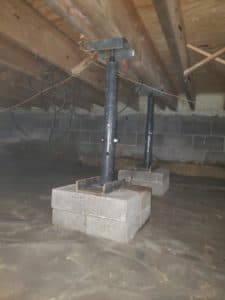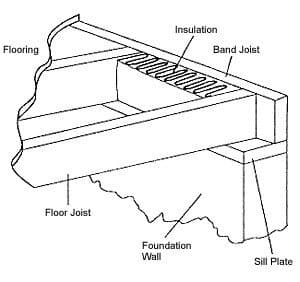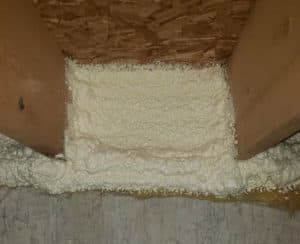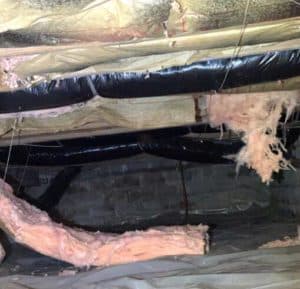
Originally posted 7/16/20, updated 12/15/22
When you’re a kid, sliding across a hardwood floor in your socks is fun. And let’s be honest, sometimes it’s fun when you’re an adult, too! But what is NOT fun is being forced to wear socks because both your floor and your feet are freezing.
Insulation is supposed to help maintain your home’s temperature. It’s meant to seal air leaks, block drafts, and hold the temperature-controlled air inside. But like many things, all insulation methods are not created equally.
Acculevel is a foundation repair company, which at first glance may not seem like the most relevant source of information about insulation. However, one of our primary services is repairing crawl spaces. And we have seen many, many examples that clearly illustrate why fiberglass insulation is a bad fit for crawl spaces. We want you to avoid the pitfalls that come with the wrong insulation type, because they can be frustrating and expensive to repair.
At one time, builders thought insulating the crawl space with fiberglass batting was a sound practice. Unfortunately, time has shown us that this is a terrible idea. Fiberglass insulation frequently comes loose and falls out of place, which is frustrating and wasteful. It’s not insulating anything when it’s falling to the ground!
 This photo was taken by an Acculevel project advisor during a routine estimate appointment. This is clearly the “before” picture. The “after” is below.
This photo was taken by an Acculevel project advisor during a routine estimate appointment. This is clearly the “before” picture. The “after” is below.
But it’s not particularly helpful even where it stays in place. Fiberglass insulation can actively cause damage to your wooden flooring structure. This is because the batting absorbs and holds water, much like a sponge. Since this damp material is attached to your joists, beams, and subfloor, the moisture gets “shared” with those wooden components.
Over time, as the fiberglass batting absorbs water, it becomes weighed down and too heavy for the fasteners to hold up. By the time it falls, it may have done substantial damage to your flooring structure.
Damp boards make an appealing home for insects like termites. Termites like softer wooden surfaces because it’s easier for them to chew. The insulation itself can be an enticing location for larger pests looking for nesting materials. And both surface types- damp wood and insulation- can develop a variety of molds. None of these things are what you want in or around your home!
Mold and water absorption contribute to how quickly wood rots. As your wooden joists and beams decay, your floors will begin to sag. The only way to fix sagging floors is to repair or replace the damaged boards.
All of these issues - mold treatment, termite extermination, flooring repairs- quickly add up to a significant expense. In the last 12 months, the average cost to repair sagging floors is about $6200, and the price range for mold treatment is $2350-$4700.
We don’t have pricing for extermination services, but if you have molding and sagging floors, we know you’re going to pay at least $8500 for repairs. If you don’t have these problems yet, then replacing your damaged or failing fiberglass insulation with spray foam is an excellent preventative measure.
 This photo was taken by an Acculevel team member, after repairs to the crawl space were completed. They removed the old insulation, installed spray foam along the outside walls, and replaced the failing wooden supports with adjustable steel jacks.
This photo was taken by an Acculevel team member, after repairs to the crawl space were completed. They removed the old insulation, installed spray foam along the outside walls, and replaced the failing wooden supports with adjustable steel jacks.
At Acculevel, we use a formula that combines two different components. Once mixed, these create a solution that can be sprayed onto any clean, dry surface. (Full disclosure: we use products from Better Energy Store.)
The spray begins as two liquids, but through the mixing process it becomes a wet foam. Immediately after spraying, the foam expands- filling every gap or crack along the way. It hardens as it dries, and becomes a solid, lightweight insulation that blocks out anything outside your home.

In our industry, spray foam is applied only to joist boxes, which are the spaces between floor joists (along the band board or band joist). It does not have to be sprayed between joists like fiberglass batting, because it completely blocks air flow at the outside perimeter. Spray foam can also be used to seal off crawl space vents for encapsulation.
To insulate crawl space walls, we recommend a blanket insulation product like radiant armor. (Foam board is another option that we discourage, because the adhesive often fails and lets the foam board fall down.)
 A close-up of spray foam installed along the band boards. This picture was taken by an Acculevel crew member after the crawl space repairs were completed.
A close-up of spray foam installed along the band boards. This picture was taken by an Acculevel crew member after the crawl space repairs were completed.
 This photo was taken by an Acculevel project advisor during a routine estimate. Some of the fiberglass insulation is falling, and what has stayed in place is beginning to mold.
This photo was taken by an Acculevel project advisor during a routine estimate. Some of the fiberglass insulation is falling, and what has stayed in place is beginning to mold.
*Please keep in mind that R-value is not always the best way to measure a material. If you have multiple layers of an insulator, you can have a high R value. But if there are still gaps or drafts through those materials, you will still have cold floors.*
While there are many benefits to spray foam insulation, there are only two significant drawbacks to it.
By far, the biggest negative is its initial cost. At Acculevel, spray foam insulation is approximately $14 per linear foot. For comparison’s sake, fiberglass insulation averages about $1.50 per square foot.
Something to consider: our cost per linear foot includes labor AND materials. The price of fiberglass insulation is something I researched, averaging out prices at a variety of hardware stores.
Dear Reader, I must admit: comparing square footage to linear footage was embarrassingly hard on my brain. If you are in the same boat, let’s row together:
Let’s assume the walls of your crawl space are 60 feet by 25 feet.
Sq footage = 60 x 25 or 1500
Linear footage= 25+25+60+60 or 170
This means you can insulate the entire crawl space with fiberglass insulation for $2250. Or you can insulate the entire perimeter with spray foam for $2380.
The other potential problem with spray foam is its permanence. If you decide to build an addition to your home, and need to access the wall of your crawl space? You will have to manually scrape the foam off the affected surface. It can’t be pulled down or easily cut away.
We’ve created a homeowner’s guide to crawl space repairs that tackles all of our customers’ frequently asked questions. This is a free resource, available to any homeowner, and includes everything from foundation damage, biological growth, insulation materials, waterproofing, and repair costs.
You’ll want to find an experienced, reputable contractor to work on your home. If you live in Indiana or the surrounding areas, call Acculevel! Our friendly customer care representatives will schedule a free appointment for you.
One of our knowledgeable project advisors will carefully come to your house and meet with you. After discussing your concerns and any symptoms you’ve noticed, they will evaluate your entire home before making any recommendations.
Our goal is to provide you with a whole-home solution. This means we want to address both the symptoms and the cause of the issue. After all, if you repair some rotting floor joists but don’t remove the damp insulation? Your floor joists are only going to rot again; why would anyone want to keep paying for the same repair?
If you don’t live in our service area, please make sure you verify that your contractor is insured and accredited by the Better Business Bureau.
Not familiar with the process of finding or meeting with a contractor? We offer a free downloadable guide of questions to ask a contractor. This can help you interview and vet companies,to find the best fit for you and your home repairs.
[DISPLAY_ULTIMATE_SOCIAL_ICONS]